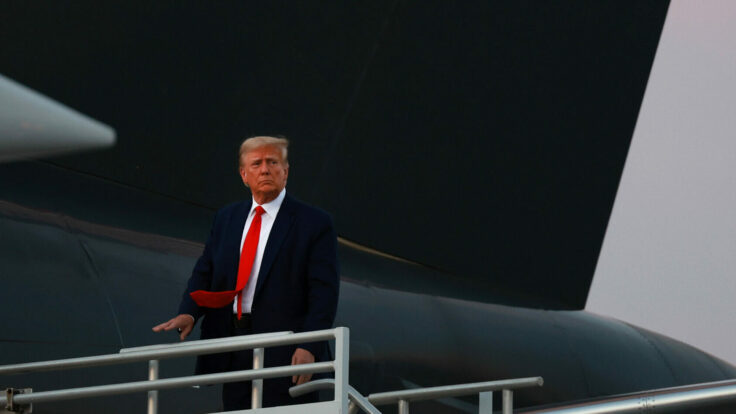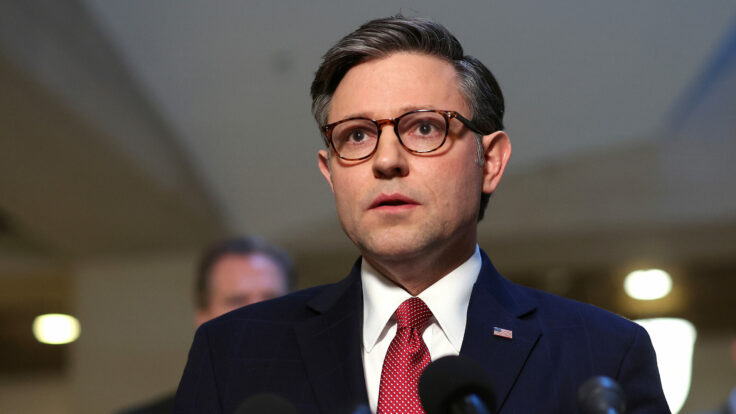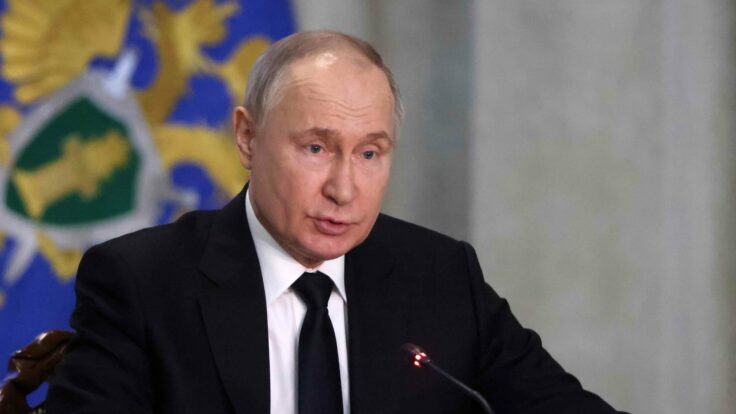At dawn last Thursday, I boarded General Mark Milley’s plane at Joint Base Andrews, along with the Chairman’s staff, a reporter from the A.F.P., and the voluble Chairman himself. Our destination was Ramstein Air Base, in Germany, for the eleventh meeting of the Ukraine Defense Contact Group, a coalition of fifty or so countries, led by the U.S., that have been providing military assistance to Ukraine. They meet once a month or so to coordinate who’s giving what—and to put the screws on the holdouts.
Because heading the Joint Chiefs of Staff—that is, the entire U.S. military—means playing whack-a-mole with international crises, Milley spent the entirety of the eight-hour flight to Ramstein on the phone with the White House and his European counterparts, trying to figure out what exactly was happening in Sudan and whether to move U.S. troops into the region to evacuate the American embassy in Khartoum. (While we were in flight, Politico broke the story that was embargoed for us: the U.S. military was prepositioning troops—moving them from Fort Bragg to Djibouti—in case President Biden gave the order to evacuate personnel, which he did over the weekend.)
As we boarded, one of the Chairman’s extremely tough-looking staffers—a Navy SEAL, I would later learn—carried a number of bags on board, most belonging to the Chairman, I assumed. One of them was a small, black, plastic case that looked especially important. “Are those the, uh, nuclear codes?” I asked one of the Chairman’s communications adjutants. They laughed. It was, they said, full of challenge coins.
For the uninitiated, challenge coins are metal coins, about three inches in diameter, that the military gives out to commemorate a challenge accepted, met, and conquered. I must have looked incredulous because Milley’s staffers opened up the case to show me. It was, in fact, full of them. It’s not quite the nuclear football, but the military, it turns out, keeps a rather stringent count of these coins, and the carrier has to fill out a form at the end of every day, accounting for any that were disbursed. “We call it the kettlebell,” the SEAL said. “You try carrying it.”
The flight, paid for by my tax dollars and yours, was quite comfortable, I’m happy to report. It was a loud, old Boeing 737, equipped with everything the Chairman would need to work en route, like secure communications and a team to operate them. (Our WiFi was periodically shut down when the Chairman made some of his more sensitive calls.) A team of young Air Force recruits, part of the 89th Airlift Wing, a unit that has a red fox as its logo, served as both pilots and flight attendants, reminding us to stow our tray tables and bringing us meals (veggie omelets for breakfast, soup and salad for lunch) and a never-ending supply of La Croix, ChexMix, and Mr. Goodbar minis.
The big leather seats were old—I accidentally snapped off a hunk of plastic from the back of one by propping up my high heels on it, and one of the buttons on the A.F.P. reporter’s seat fell into the depths of the armrest—but they were cozy. Besides, it would have been a sin to complain when, as we discovered the next day at Ramstein, Defense Secretary Lloyd Austin’s press pool had traveled for four days on a cargo plane. When our arrangements became known, the Times and Politico reporters in the SecDef’s pool asked if we had any extra room on our flight. (No, we didn’t, and yes, people actually say “SecDef” out loud.)
The Ramstein Group
The work began the following morning, when the SecDef, the Chairman, NATO Secretary General Jens Stoltenberg (“SecGen”), and the defense ministers of the attending nations pulled into the driveway of a drab brown building on base. Media was corralled in a big freezing room with a rotating buffet of extremely American food, but some of us got to venture out to see the SecDef gavel the Contact Group into session.
Sitting at the head of a giant U-shaped conference table, Austin praised the group’s “moral clarity” and “unity,” as well as the fact that it had collectively sent $55 billion in security assistance to Ukraine, some of it in the form of lethal aid, like tanks and air defense systems, and some in the form of training for Ukrainian soldiers.
Austin also had to address the Jack Teixeira-sized elephant in the room. “Now, I know that many of you have been following the reports of the unauthorized disclosure of sensitive and classified U.S. material,” Austin intoned in his deep baritone. “I take this issue very seriously and we will continue to work closely and respectfully with our deeply valued allies and partners. And, as I discussed this issue with our allies and partners, I was struck by your solidarity and your commitment to reject efforts to divide us. And we will not let anything fracture our unity.” Sitting next to him, Chairman Milley stared straight ahead, as did Ukrainian defense minister Oleksiy Reznikov, who was seated with his extremely muscular delegation to the Chairman’s left. Presumably, they were less than amused by what Teixeira allegedly revealed about the Americans’ lack of confidence in Kyiv’s ability to claw back territory from the Russians later this spring.
Still, most people didn’t seem overly concerned about the leaks. One European official at the big table later told me that the leak didn’t really come up after the press was hustled out of the room in the closed-door sessions. There was an understanding, this official told me, that “this happens.” When I asked Milley if anyone had brought up the intelligence breach in the meetings, he said, “A couple, but not very much, no.”
Others, like Canadian defense minister Anita Anand, came prepared with memorized talking points. Two days before the meeting of the Ramstein Group, the Washington Post published yet another revelation from the Discord leaks: Apparently, Canadian Prime Minister Justin Trudeau had privately told NATO officials that Canada would “never” hit the two-percent defense spending target required of all NATO members. “I’m not going to comment on the alleged leaked documents, but I will say that Canada continues to make foundational investments in its defense and military spending,” Anand said when I asked her about the story during her press conference. She rattled off a list of numbers of dollars spent on various projects but when I tried to press her on it, she stuck to the script “As I said,” she replied, smiling tensely, “we are on an upward trajectory.”
But at least Canada was giving lethal aid, which was more than could be said for other countries at the table, like Japan and Hungary. (Israel, too, had been a periodic, non-lethal-aid-providing participant.) Extremely pro-Russian Hungary was technically a NATO member, but no one could name what, exactly, it had provided for Ukraine’s defense. “Well, at least they’ve supported NATO efforts, and NATO is providing different types of support,” Stoltenberg said when I asked him about it in between meetings. “I don’t have on the top of my head exactly what Hungary has done, but they have been part of the NATO efforts.” He then clarified that Hungary had taken in refugees and done other unspecified things to help Ukraine. “Different allies do different things!” Stoltenberg protested.
Others were less diplomatic. “Nothing,” a Baltic official said with a look of sour disgust when I asked them the same question. “Some countries just come here to gather information.” The Baltic countries, the official noted, have spent the most of anyone else as a percentage of G.D.P., more even than the U.S., a statistic that the Chairman’s staff later confirmed. “It’s not NATO helping Ukraine,” the Baltic official said pointedly. “It’s individual countries helping Ukraine.”
Into the Breach
On the plane ride home, I asked Chairman Milley about the frustration I hear back in Washington about his very public and not very optimistic prognoses for Ukraine’s military. Since the fall, he had been saying that Ukraine could not win this war militarily and that it would, at some point, have to come to the negotiating table. (Though, to be fair, he has also said that Russia can’t win the war militarily, either.) “It feels like Milley’s analysis is our policy,” one D.C. think tank chief complained to me privately. “Why are you so negative publicly?” they wondered aloud, as if addressing the Chairman himself. “Whether it’s true or not, how does it help? What are you trying to achieve with the negative comments? I’m glad he’s been told privately to knock it off.”
“Well, first of all, I don’t think in terms of optimist or pessimist or defeatist, I think in terms of realist,” Milley said—or, rather, shouted over the scream of the engines. “I’m a soldier and I try to deal in realistic analysis of a lot of the military factors that go into the conduct of battle and war. It’s based off of intelligence analysis. I’m not trying to project defeatism or optimism. I’m just trying to be realistic. I personally think that the Ukrainians have done extraordinarily well. I think the Ukrainians have fundamentally defeated the Russian army.” (According to his staff, it’s not just intelligence that Milley uses to understand what is happening in the world. A voracious reader who starts his day by reading the morning press at the very #thistown hour of 4 a.m., he also supplements his information diet with a healthy, steady dose of Twitter.)
Think about that, Milley continued. “Here’s a country the size of Ukraine, and, over the last year, from a cold start in February of last year, they have prevented the Russian army, the Russian military, from achieving their strategic objectives. That’s an incredible military feat, it really is.”
We were sitting in the back of the plane, the A.F.P. reporter and I on the couch, Chairman Milley at his desk. We finally had a moment to speak to him on the record before he had to hop on the phone with the head of the French military and talk Sudan. We had been treated to a long and off-the-record explanation, complete with a military map, of what had happened in the first year of the war and what awaited Ukraine in the coming months.
After the conversations I had at the Ramstein forum, though, it was hard to fault Milley for being pessimistic. Various Western officials, both military and civilian, worried aloud about Ukraine’s spring offensive. Russia has built a web of trenches so massive, they can be seen from space. Any military analyst will tell you that taking territory is a far costlier proposition than defending it, but the chatter at Ramstein was that Ukraine was about to walk into a buzzsaw. If Ukraine attacked to the southeast toward the Azov Sea, as has been widely and publicly speculated, aiming to retake Melitopol and cut Russian supply lines between Crimea and mainland Russia, the country would be going after some of the most heavily fortified—and most strategically important—Russian installations. This breaching operation, as it is known in the military, is one of the hardest and bloodiest maneuvers to pull off in general, and the Ukrainians have already been bled for over a year of brutal fighting. One Ukrainian journalist approached me on the patio at Ramstein and, wringing his hands, asked me what the talk was in Washington. What would run out first, he wondered aloud, America’s appetite to support Ukraine—or Ukrainian men of military age? Because the latter scenario, he added, was fast approaching.
Most reporting has focused on astronomical Russian casualties, but some U.S. officials have estimated that Ukraine has lost some 200,000 soldiers to death and injury in the last 14 months. The fighting ahead would be even bloodier. The U.S. military generally prepares for a casualty ratio of 3:1 when planning a breaching operation, with the attacking side bearing the brunt of the bloodshed. But one official at Ramstein told me it might be even worse: 50,000 Ukrainian casualties in the first two months alone. Another speculated that half of both armies in the area of the offensive would be wiped out in a matter of months. And would Ukraine even succeed? Everyone hoped so, but the jitters were palpable. “I’m looking forward to the next meeting [of the Ukraine Defense Contact Group] in June when we have some results from the Ukrainian offensive,” the European official told me.
The Rules-Based Order
As we approached Andrews in the early evening, I asked Milley if he thought Ukraine could win the war according to their own definition of victory, and the Chairman, who speaks in tomes, was determined to strike a more optimistic tone, especially after my first question. “If Putin wins, if Putin is successful, then China learns a lesson, Iran learns a lesson, and the rules-based order goes up in smoke,” he said. He then noted that this rules-based order—the status quo that Putin and Xi Jinping have endlessly critiqued—has helped avoid the sort of great-power war that consumed the world in the last century.
“For Ukraine, it’s an existential fight for their own freedom,” he noted. “But for NAТO in Europe and for for the United States and other countries, it’s about the rules. That’s the purpose. So then the question becomes, okay, if that’s what it’s about, how do you know when you win and what is winning? Winning, according to President Biden and all of the senior political leaders of Europe, is that Ukraine, at the end of the day, must remain a free, independent, sovereign country with its territory intact. If that is true, if that happens, then the rules-based order is upheld and Putin is defeated.”
“Of course, we want Ukraine to win,” he went on. “We’re not sinking billions upon billions upon billions of dollars in Ukraine just to think otherwise. We want them to win. They must win. And we are going to do everything we need to do to help them win because the purpose is so important to the United States and NATO and Europe.”
“In their 1991 borders?” I asked.
“That’s a great question,” Milley stalled. “And the answer is that the borders of Ukraine will be determined by the Ukrainians. It’s not for us to say what the borders of Ukraine are. If they want to determine that through a negotiation, fine. But the bottom line is we are going to help Ukraine until that end state is met. That’s what our president has said and that’s what our military does—to help them, to train, advise, assist, provide military equipment, et cetera, to make sure that they have the wherewithal, the means of achieving that success.”
“The Ukrainians have demonstrated a degree of will, resilience, toughness, and grittiness that’s remarkable,” the Chairman added. “Ukraine has a national identity. It has history there. They’ve been free—and a free people are not easily conquered.”

















